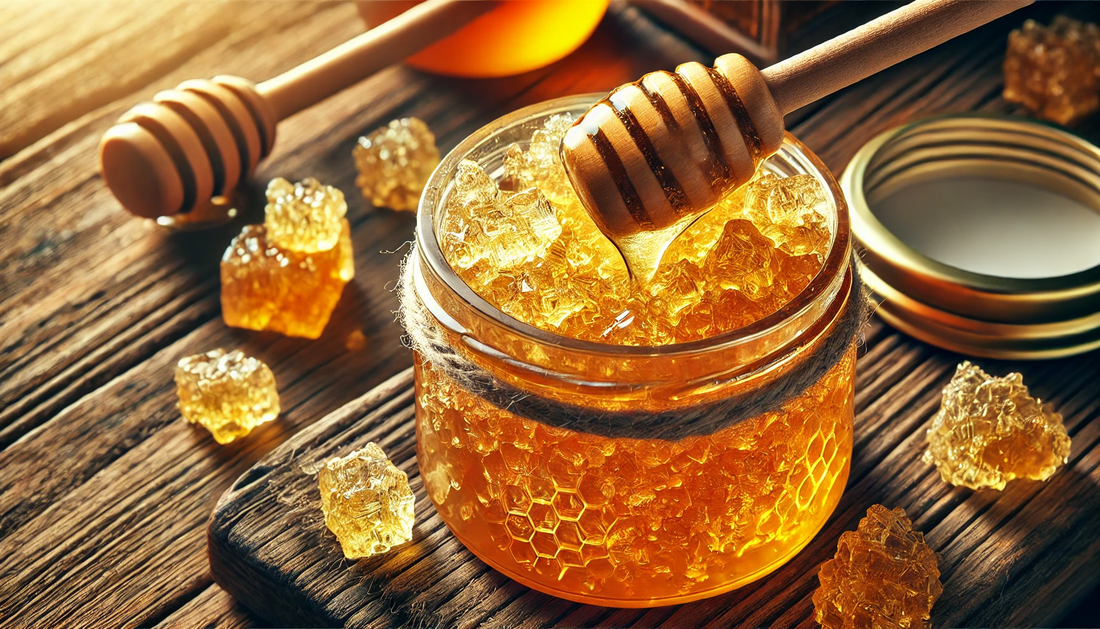
Crystallization of Raw Honey – Debunked!
Share
Raw honey is a nutritional powerhouse, packed with natural enzymes, antioxidants, and antimicrobial properties. However, many people are surprised when their jar of honey transforms from a smooth, golden liquid into a thick, grainy texture. This process, known as honey crystallization, often raises questions: Is the honey still safe to eat? Has it gone bad?
The answer is simple—crystallization is a natural and expected process in raw honey, and in fact, it’s a sign of high-quality, unprocessed honey. Let’s explore why raw honey crystallizes, how to handle it, and why it remains just as delicious and beneficial in its crystallized form.
Why Does Raw Honey Crystallize?
Crystallization occurs when the natural sugars in honey (glucose and fructose) separate and form crystals. The rate at which honey crystallizes depends on several factors:
1. Sugar Composition
Raw honey contains two main types of sugar:
- Glucose – A sugar that is prone to crystallization. The more glucose in the honey, the faster it will crystallize.
- Fructose – A sugar that remains liquid. Honey varieties with higher fructose levels crystallize more slowly.
Each type of honey has a unique glucose-to-fructose ratio, which explains why some varieties crystallize faster than others. For example, clover honey crystallizes quicker than acacia honey, which has a higher fructose content.
2. Temperature Changes
Temperature plays a crucial role in the crystallization of honey:
- Honey stored at cool temperatures (below 10°C / 50°F) crystallizes much faster.
- Room temperature (18-24°C / 64-75°F) helps slow down the crystallization process.
If honey is exposed to extreme cold, such as refrigeration, it can crystallize in a matter of weeks.
3. Presence of Pollen and Other Particles
Raw honey is unfiltered, meaning it contains tiny pollen particles, beeswax, and other natural elements. These particles act as “seeds” for crystallization, helping sugar crystals to form.
Commercial honey, which undergoes pasteurization and ultra-filtration, removes these natural elements, delaying crystallization. However, this also strips honey of some of its beneficial enzymes and nutrients.
4. Natural Process in Raw Honey
Unlike processed honey, which is heated to high temperatures to prevent crystallization, raw honey retains all of its natural properties. Crystallization is actually proof that your honey is real, pure, and unprocessed.
Is Crystallized Honey Still Safe to Eat?
Yes! Crystallized honey is perfectly safe and just as nutritious as liquid honey. In fact, many people prefer its thicker, spreadable texture. Crystallized honey can be easily used in:
- Tea and Coffee – It dissolves just as easily as liquid honey.
- Toast and Oatmeal – A great natural alternative to processed spreads.
- Baking and Cooking – Adds natural sweetness to recipes.
How to Restore Crystallized Honey to Liquid Form
If you prefer liquid honey, you can gently return crystallized honey to its original form using a warm water bath:
- Place the honey jar in a bowl of warm (not boiling) water.
- Stir occasionally until the crystals dissolve.
- Avoid using a microwave, as excessive heat can destroy honey’s natural enzymes and beneficial properties.
To prevent honey from crystallizing quickly, store it at room temperature in a dry, dark place away from direct sunlight.
The Truth About Honey Crystallization
Crystallization is a natural and beneficial characteristic of raw honey, not a flaw. If your honey crystallizes, it simply means that it is in its purest, most natural state—free from excessive processing.
When buying honey, look for raw, unfiltered options that retain all the nutrients and flavors that make honey such a valuable addition to your diet. Whether smooth or crystallized, raw honey remains a nutritious, versatile, and delicious choice for everyday use.
